FRAGMENTS OF WAR – PICTURES FROM UKRAINE
Curated by Andy Heller and Mirja Linnekugel
Willy-Brandt-Haus, Berlin
July 1 – August 22, 2022
Group exhibition with Johanna-Maria Fritz, Helena Lea Manhartsberger and Laila Sieber
The exhibition Fragments of War – Pictures from Ukraine shows the photographs of Johanna-Maria Fritz, Helena Lea Manhartsberger and Laila Sieber. The three photographers made their way to Ukraine at the beginning of the war. They wanted to be there themselves and capture the incomprehensible in pictures: a war of aggression in Europe, an attack on democracy.
In their pictures, they capture fragments of this unbelievable attack: they show the individual fates of those affected and provide insights into their current living environment. Their focus is on showing the very personal experiences and individual fates of those portrayed, as well as snapshots of the last few weeks and months – exemplary for so many tragic stories of suffering and facets of this war.
The Ostkreuz photographer Johanna-Maria Fritz was unfiltered and close to the people for her series A grave in the Garden. She was there when Bucha’s war crimes became visible, she saw and documented the destruction in Kyiv and Irpin, saw the horror on the streets, the destruction of the war. Her pictures are moving testimonies to the current tragedy. She says about how the photographs were taken: „One day after the liberation, we were almost the first journalists to visit the place in Bucha. People were happy about the end of the occupation, but the wounds of war were still everywhere. Only after the liberation did the residents of Bucha understand the real extent of the terror.”
The series Where you can hear the silence by Helena Lea Manhartsberger and Laila Sieber is a sensitive portrait of the first days of the war away from the front line. The two photographers started their journey to western Ukraine together. They met people there who dealt with the new reality in very different ways. Some prepared to flee the country, others to defend their homes and stay. The complexity of the war becomes visible in the confrontation with individual fates. About their series they say: „The silence that can be heard sometimes gets quieter when there is loud laughter in conversation. Then she screams again when worry about relatives who are still on the run leaves you speechless. But she is a constant companion in this war.” The two photographers accompany the fugitives to this day – video messages continue to tell the stories in the exhibition.
Opening
June 30, 2022 at 7 pm
Introductions by
Mirja Linnekugel (artistic director, Freundeskreis Willy-Brandt-Haus)
Tamina Kutscher (chief editor, dekoder.org)
Ingo Taubhorn (chief curator, Haus der Photographie, Deichtorhallen Hamburg)


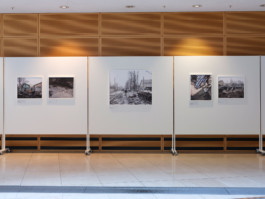


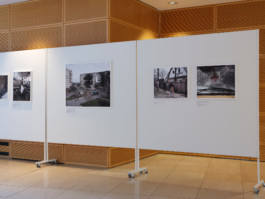
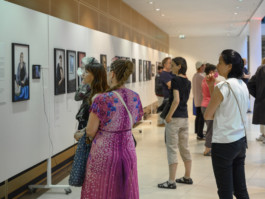
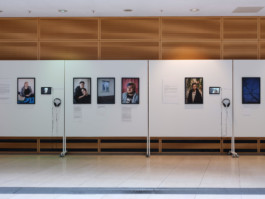
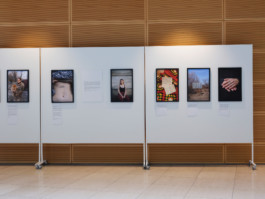


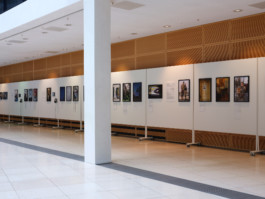
Publications | SelectioN
Jana Redweik: Fragemente des Krieges – Fotos aus der Ukraine
Frankfurter Allgemeine Zeitung, July 1, 2022 (dt)
Tomas Fitzel: Neue FotoAusstellung im Willy-Brandt-haus – Fragemente des Krieges
RBB Radio Kultur, July 1, 2022 (dt)
Mathias Richter: Gesichter des Krieges – Zwei Fotoausstellungen über die Ukraine
„(...) Im Willy-Brandt-Haus in Berlin-Kreuzberg hängen 34 Fotografien der Ostkreuzfotografin Johanna-Maria Fritz und ihrer beiden Kolleginnen Helena Lea Manhartsberger und Laila Sieber. Fragmente des Krieges – Bilder aus der Ukraine ist die Schau überschrieben. Nur eine halbe U-Bahn-Stunde davon, in Dahlem zeigt das Museum für Europäische Kulturen Aufnahmen der ukrainischen Künstlerin Mila Teshaieva. Splitter des Lebens – Ein Ukraine Tagebuch lautet der Titel der Schau, in der die Künstlerin die Ereignisse von 18 Tagen im Ukrainiekrieg protokolliert und entsprechende Fotos dazu gemacht hat. Beiden Ausstellungen gemein ist, dass die Fotografinnen gleich in den ersten Tagen des Krieges vor Ort waren und dass ihre Bilder neben der physischen Zerstörung vor allem die Menschen zeigen, die damit zurechtkommen müssen. Es sind gewissermaßen Psychogramme des Krieges. (...)"
Märkische Allgemeine, July 26, 2022 (dt)
Anastasia Trenkler: Kriegsbilder aus der Ukraine – Momente der Wahrheit
„(...) „Wir begannen Mitte März, die Ausstellung zu organisieren. Die Eröffnung war für Juni geplant. Wir mussten uns also fragen: Wie gehen wir damit um, dass wir überhaupt nicht wissen, wie sich der Krieg weiterentwickeln wird?“, sagt Andy Heller, die die Schau im Willy-Brandt-Haus kuratiert hat. (...) Fotografinnen wie Manhartsberger, Sieber und Fritz ist es zu verdanken, dass die Bilder des Krieges in den vergangenen Monaten die Welt aufgerüttelt haben. Sie dokumentieren, welche Schrecken nicht weit von Berlin passieren. Trotz der Masse an Bildern – oder gerade deswegen – sei es wichtig zu hinterfragen: „Was wird gezeigt und was nicht?“, sagt Manhartsberger. Es gebe stets mehrere Perspektiven, jede Geschichte sei anders und könne sich wandeln. Bilder jedoch zeigen lediglich Fragmente. Es bleiben Momentaufnahmen."
Tagesspiegel, August 8, 2022 (dt)
Gefördert von der Beauftragten der Bundesregierung für Kultur und Medien
